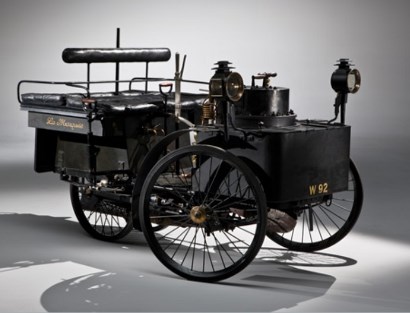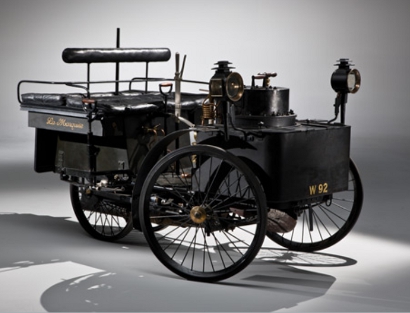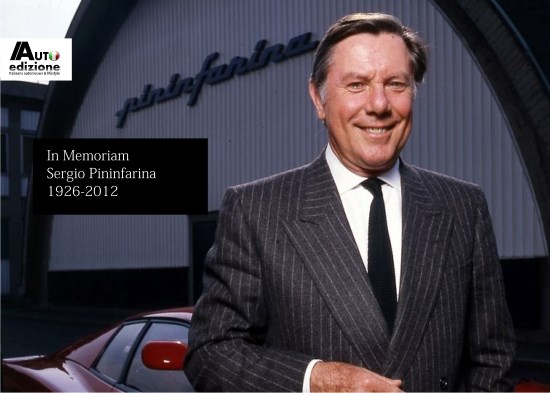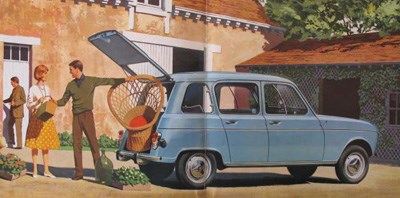
The oldest running car in the world! Named "La Marquise" after the Count de Dion's mother, this 127-year-old automobile had single-family ownership for 81 years and currently has only four owners from new. La Marquise was even a participant in the first automobile race in 1887.
This prototype car was produced in DeDion, Bouton and Trepardoux's new factory in the Rue des Pavillons at Puteaux. It could seat four people; the rear passengers had their backs to the driver and front passenger. This type of positioning would become known as dos-a-dos. The four passengers sat atop a large rectangular sheet-iron tank. The tank held water for the vertical boiler, which could be found in front of the driver. The car was powered by two independent tandem-compound engines located underneath the floor. The power they produced each powered one wheel. That power was sent via a connecting rod and overhung cranks.
DeDion named the prototype car 'La Marquise' in honor of his mother. It would be used in 1887 in the 20-mile race from the pont de Neuilly in Paris to Versailles and back. La Marquise was the only light steamer in the race. Bouton drove the solo race in 1 hour and 14 minutes with an average speed of 16 mph. Top speed was reported to be 37 mph.
In 1888 DeDion drove La Marquise to a victory over Georges Bouton who was driving a light steam tricycle.
The Count would retain La Marquise for many years, even after the popularity of steam powered cars faded. After many years, the next owner of the steamer was an artillery officer named Doriol. By this point in history, some of the little carriage's bonze and copper plumbing had been stripped and used for making shell casings.
La Marquise was displayed at the 1925 Grand Exhibition in Grenoble and was awarded a Special Diplome d'Honneur. A restoration was attempted but never really finished until June of 1987, when it was sold for only the second time in its life. A British individual was its next owner, who acquired permission to have it exported from France. A complete restoration was commissioned bringing it to original running order.
This car is a multi-award winning vehicle, as would be expected. It outclasses every rival in terms of heritage, distinction, uniqueness, pedigree, and history. It won the UK National Steam heritage Premier Award for Restoration and Preservation in 1991. In 1997 at the Pebble Beach Concours d'Elegance, it was a double first place winner, winning the U1 class for pioneer steam cars. The Automobile Quarterly awarded it the Historians Trophy for the 'Most Historically Important Car at the Show.'
It was honored at the 1996 Louis Vuitton Concours at the Royal Hurlingham Club, London. It was class winner of pre-century steam vehicles in 1999 at the Cartier 'Style et Luxe' Concours at the Goodwood Festival of Speed. In 1994 and 1998 it made featured demonstration runs at the Goodwood Festival of Speed.
It has completed the 62-mile London-to-Brighton Veteran Car Run and the Evelyn Ellis Centenary Run.
The car has changed ownership only twice in nearly 125 years. It is the world's oldest racing car, the world's oldest functioning automobile in private hands, and the holder of many prestigious awards.
In 2007 it was brought to auction and offered for sale. This was a rare opportunity that truly is a once-in-a-lifetime affair. It was one of the highlights of the auction and took a prominent display location throughout the auction preview days. As it crossed the auction block, bidding was energetic. As the gavel fell for the third and final time, the lot had been sold for $3,520,000 including buyer's premium.

In 1985 De Dion created the first automobile club and in 1898 organized an auto show in Paris, the first auto show the world had ever seen. By the close of the 1890's, the 3.5 horsepower rear-engined petite voiture had become the world's first series-production small car.
Over 150 various motorcycle and automobile manufacturers bought licenses to build the Bouton and De Dion engine. By 1900 De Dion and Bouton was the world's largest maker of automobiles with annual production of 400 cars and 3,200 engines. By 1904 De Dion had supplied over 40,000 engines produced by their Puteaux facility.
Another individual responsible for the success of the DeDion motorcar was Charles-Armand Trepardoux. He was a graduate of Angers Ecole Imperiale des Arts et Metiers in 1871 and by 1877 had been working with Georges Bouton, the mechanical engineer. In their workshops in the Passage Leon, near the Gare du Nord in Paris, they produced engineering models and scientific instruments for collectors. They also produced steam boats and engines for the Giroux Company.
Near the beginning of 1882, Comte de Dion was seeking prizes and novelty items for an event, when he was entranced by the workmanship on a model steam engine. After some searching, he found the craftsman, Bouton and Trepardoux where were struggling, at the time, to make a living. Immediately, the pair was commissioned by DeDion to create a compact boiler. In 1882 a company was formed, dubbed Trepardoux & Cie as the ministry only recognized the qualifications of Gadz'Arts engineers for issuing boiler certificates. The name would be used until 1886.
Their first experimentation with a steam engine was in a pedal tricycle as early as 1883. A Victoria quadricycle with rubber-shod wheels soon followed. It was driven by twin belts and had rear wheel steering. It was a very early design that was very dangerous; the liquid fuel had a tendency to catch fire. A new design was constructed, one that would use coke (a coal derivative) as its fuel.
In 1884 a four-passenger car was built using locomotive principles. Steering was in the front and power was sent to the rear wheels. This design proved promising and would become the basis for a series of three- and four-wheeled automobiles. Confident with their creation, they issued their first sales catalogue in 1886. It is believed that around five or six quads were constructed and over 20 tricycles were built for customers. Around 30 examples of these light private steamers were constructed by 1894.
The steam powered cars would outpace the internal combustion for the next fifteen years. The DeDion proved its merit in the 1894 Paris-Rouen race, finishing in first place.
Heavier steam tractor units soon followed. DeDion, concerned about animal's welfare, was intent on freeing horses from the burden of pulling heavy carts. The potential of the internal combustion engine was also appealing.
Trepardoux, the steam engineer, left the partnership on May 27th of 1893. Bouton's work shifted to developing high-speed gasoline engines and as the world braced for the start of the 1900s, the DeDion-Bouton company had become the world's most successful automobile manufacturer. Their engines could be found in many automobiles and motor-driven vehicles throughout the world. Renowned companies such as Renault, Delage and Pierce-Arrow relied on the designs of the DeDion engine to power their cars.
Trepardoux's fate did not share the same success; it was much the opposite, filled with personal tragedy.
The DeDion Company prospered, introducing a tw-cylinder engine in 1903 which produced 12 horsepower. Two years later a four-cylinder version capable of producing between 15 and 24 horsepower, depending on configuration, had been developed.
In 1908 the company produced their final 8 horsepower single cylinder engine and all models were now equipped with conventional gearboxes.
In 1910 De Dion and Bouton introduced a eight-cylinder engine in 'Vee' configuration, another innovative achievement for the duo. The 6.1-liter engine was capable of producing 35 horsepower. The displacement was further enlarged to 7.8-liters and again to 14.7-liters. The eight-cylinder engine was used until 1923 when a new OHV 12-cylinder engine with aluminum pistons was introduced.
With national tragedies such as World War I and the onset of the Great Depression, the De Dion company began to struggle financially. During 1927 it ceased production temporarily and when it resumed production it had a new 2.5-liter straight eight-cylinder and a 2-liter four-cylinder engine. Sales were sluggish so the decision was made to increase the displacement to 3-liters in 1930.
In 1932 the last automobile produced by the De Dion Company was produced. It continued to produce trucks until the close of the 1940's when it shifted its focus to servicing automobiles, trucks, and motorcycles.








